第1课时(Story time)教案
牛津译林版五上U6第1课时(Story time)教案

五年级上册第六单元第1课时教案Teaching contents 教学内容Story timeTeaching aims and learning objectives 教学目标1. 能听懂、会读、会说e-friend, send, email, to, live, UK, …years old, study2. 能听懂、会读、会说日常用语Wait a minute. Does he/she have…? Yes, he/she does.Does he/she like…?No, he/she doesn’t.3. 能正确地理解并朗读对话内容,在教师的引导和帮助下尝试复述课文内容。
4. 能初步运用本课所学的词汇和日常用语谈论自己的朋友。
Focus of the lesson and predicted area of difficulty 教学重点和难点教学重点:能正确地理解并朗读对话内容,在教师的引导和帮助下复述课文内容。
教学难点:能初步用句型Does he/she have/like…? Yes, he/she does.来询问他人朋友。
Teaching procedures 教学过程Step 1 Brain stormingT: Say the same kind of words. The more the better.【设计意图:由游戏导入,在活跃气氛的同时唤醒学生的旧知。
】Step 2 Self-introduction1. An information cardT: This is me. Do you want to know me? You can ask me some questions.Name ---- What’s your name? ---- JollyAge ---- How old are you? ---- 33 years old (教….years old)Subjects ---- What subjects do you like? ---- EnglishHobbies ---- What do you like doing? ---- making friends2. Let’s guessT: I have a kind of special friend. We can’t see each other. We usually send emails to each other.Can you guess? (教send, send to, email )S: E-friend. (教e-friend )(引出课题Unit 6 My e-friend)【设计意图:简单介绍自己,激发学生的提问兴趣,复习已学问句,引出下个环节。
译林版四年级英语上册unit4第1课(Storytime)教案
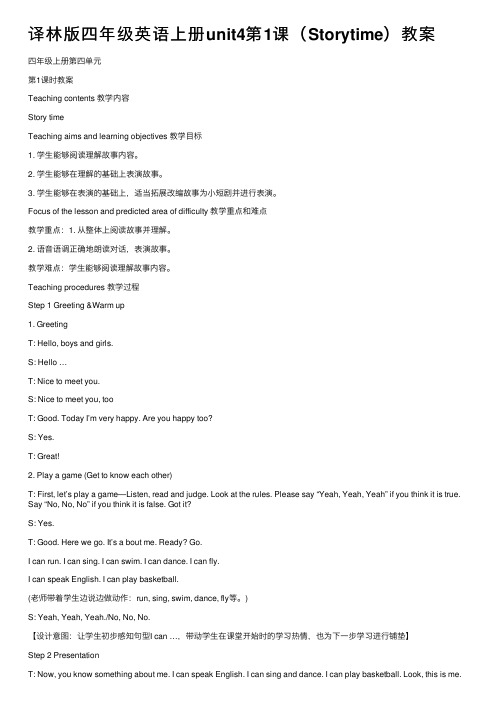
译林版四年级英语上册unit4第1课(Storytime)教案四年级上册第四单元第1课时教案Teaching contents 教学内容Story timeTeaching aims and learning objectives 教学⽬标1. 学⽣能够阅读理解故事内容。
2. 学⽣能够在理解的基础上表演故事。
3. 学⽣能够在表演的基础上,适当拓展改编故事为⼩短剧并进⾏表演。
Focus of the lesson and predicted area of difficulty 教学重点和难点教学重点:1. 从整体上阅读故事并理解。
2. 语⾳语调正确地朗读对话,表演故事。
教学难点:学⽣能够阅读理解故事内容。
Teaching procedures 教学过程Step 1 Greeting &Warm up1. GreetingT: Hello, boys and girls.S: Hello …T: Nice to meet you.S: Nice to meet you, tooT: Good. Today I’m very happy. Are you happy too?S: Yes.T: Great!2. Play a game (Get to know each other)T: First, let’s play a game—Listen, read and judge. Look at the rules. Please say “Yeah, Yeah, Yeah” if you think it is true. Say “No, No, No” if you think it is false. Got it?S: Yes.T: Good. Here we go. It’s a bout me. Ready? Go.I can run. I can sing. I can swim. I can dance. I can fly.I can speak English. I can play basketball.(⽼师带着学⽣边说边做动作:run, sing, swim, dance, fly等。
牛津译林版五上U5第1课时(Story time)教案

五年级上册第五单元第1课时教案Teaching contents教学内容:Story timeTeaching aims and learning objectives教学目标:知识目标:1. 能听懂、会说、会读和会拼写单词teacher, teach, write, work, doctor, help, worker2. 能听懂、会说、会读单词writer, at home, sick, people, factory3. 能听懂、会说、会读和会写关于职业的第三人称句型的问与答What does he/she do?He’s/She’s a ...4. 能掌握动词teach,write,work,help,make的第三人称单数形式,并能初步运用句型What does ... do? He’s/She’s a ... He/She... 来讨论Story time中涉及的职业并进行相关描述。
能力目标:1. 学生能够使用重点句型来讨论职业名称和工作内容。
2. 学生能阅读并理解故事。
情感目标:培养学生对职业的认识以及对各种职业的尊敬。
Focus of the lesson and predicted area of difficulty教学重点和难点:教学重点:1. 在故事情景中阅读和理解句型What does he/she do? 及其回答He’s/She’s a teacher/writer/ factory/ worker/ …2. 能整体到局部再到整体的理解故事内容。
3. 能用正确的语音语调朗读故事。
4. 能尝试运用句型What does Mike’s/Su Hai’s father/mother do? He’s/She’s a ..来讨论Storytime的故事。
教学难点:1. 单词sick, factory, writer, people单词的读音2. 在故事情景中正确朗读和理解What does he/she do? 及其回答He’s/She’s a teacher/writer/ factory/ worker/…3. 通过教学活动初步了解主语是第三人称单数动词的变化形式。
五年级上册第1课时(Story time)教案

五年级上册第一单元第1课时教案Teaching contents 教学内容Story timeTeaching aims and learning objectives 教学目标1. 在整体理解的基础上听懂、会说、会读故事中出现的词汇:bear, forest, there, soup, just right, hard, soft, afraid;2. 基于故事能够听懂、会说、会读和会写词汇:house, room, in front of, her;3. 基于故事听懂、会说、会读句型:There is … There are …并理解句型的意思;4. 能够听懂、会说、会读日常用语:What a beautiful …! This… is too … Help;5. 能理解故事并有感情地朗读故事;6. 能和同学合作表演故事。
Focus of the lesson and predicted area of difficulty 教学重点和难点教学重点:1. 在听故事的过程中理解相关词汇及there be句型;2. 能够从整体到局部理解内容;3. 能以正确的语音语调朗读故事,合作表演故事。
教学难点:1. 单词afraid, front的读音和拼写,教师可以通过TPR及直拼法教学进行教学;2. there be 句型在本单元中第一次出现,教师充分利用文本情景帮助学生理解;3. 本课故事的结构由讲述和对话构成,建议在整体理解的基础上分场景进行详细分析和描述。
Teaching procedures 教学过程Step 1 Warm-upFree talk.T: Welcome back to school! Nice to see you again! This is our first lesson of the newterm. Today, I’ll tell you a story as a gift for your new term. Do you like stories? S: Yes, I do.T: Good. Now let’s read a story together.【设计意图:创设情境,引出讲故事这一话题。
人教版(新起点)英语六上unit 1《in china》(story time)教学设计

Unit1 Story Time教学设计【内容来源】人民教育出版社(一起点)六年级上册Unit1 In China【课时】Story Time一、教学目标1. 能够在教师的引导下,借助图片和其他阅读策略读懂本单元的故事,完成B项的句子排序,并尝试复述故事。
2. 能够通过小故事的学习,了解春节文化和习俗。
二、教学建议读前活动1. 播放视频讲授新课前,教师可以播放一些反映中国春节习俗的视频或画面。
播放完毕后提问学生:What festival is it? 待学生说出答案后,教师进一步就春节的话题提问学生,如:What do we eat? What do you do at Spring Festival? How do you decorate your house at Spring Festival?2. 自由谈话教师问学生是否知道“过年”的来历,请了解的学生简单介绍一下。
这样可以进一步引出本节课的主题。
读中活动1. 看图描述,预测故事教师依次出示故事中的六幅插图,请学生看图描述。
在学生描述的同时,教师适时将重要的生词板书在黑板上,如:Nian, firecrackers, afraid, run back, red paper等。
这些生词有些是从图片上可观察到的。
2. 初读故事,抓住大意教师引导学生打开课本,自主阅读故事。
教师可以提出几个关于主旨的问题,如:Where did he come from? What did he do in the village? Who had got a good idea?3. 精读故事(1) 教师可依据每幅图片提出相应问题,激发学生阅读兴趣。
每幅图的问题参考如下。
Picture 1:What was the monster’s name? What did the monster do before the new year?Picture 2:Who was not afraid of the monster and could scare the monster away?Picture 3:What could you see on the door and windows? What did the monster hate?Picture 4:What did the old man wear and what did he do?Picture 5:Where were the people then?Picture 6:Now, every year, what do Chinese people do?(2) 语境中处理生词。
五年级上册英语教案Unit 5 What do they do(第一课时Story time)译林版(三起)
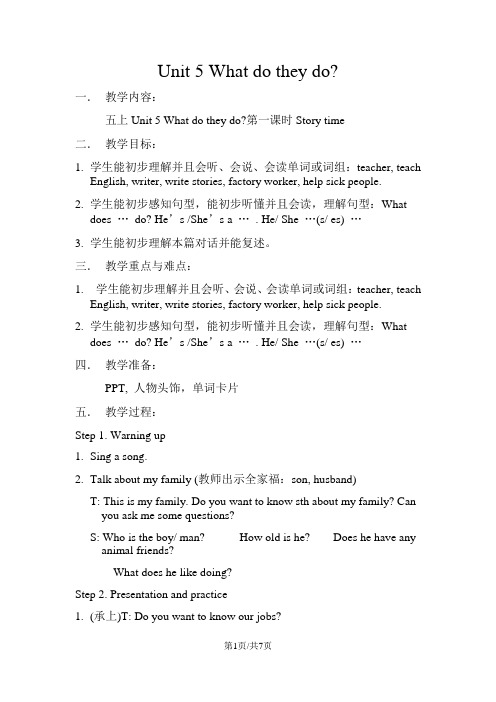
Unit 5 What do they do?一.教学内容:五上Unit 5 What do they do?第一课时Story time二.教学目标:1.学生能初步理解并且会听、会说、会读单词或词组:teacher, teachEnglish, writer, write stories, factory worker, help sick people.2.学生能初步感知句型,能初步听懂并且会读,理解句型:Whatdoes …do? He’s /She’s a …. He/ She …(s/ es) …3.学生能初步理解本篇对话并能复述。
三.教学重点与难点:1.学生能初步理解并且会听、会说、会读单词或词组:teacher, teachEnglish, writer, write stories, factory worker, help sick people.2.学生能初步感知句型,能初步听懂并且会读,理解句型:Whatdoes …do? He’s /She’s a …. He/ She …(s/ es) …四.教学准备:PPT, 人物头饰,单词卡片五.教学过程:Step 1. Warning up1.Sing a song.2.Talk about my family (教师出示全家福:son, husband)T: This is my family. Do you want to know sth about my family? Can you ask me some questions?S: Who is the boy/ man? How old is he? Does he have any animal friends?What does he like doing?Step 2. Presentation and practice1.(承上)T: Do you want to know our jobs?Ss: Yes.T: You can ask me: What do you do?/ What does the boy/man do?(PPT出示) Who can try?S1:What do you do?T: I’m a teacher. I teach English. (PPT出示) Teacher is myjob.渗透teacher, teachS2: What does the boy/ man do?T: He’s a student. He studies in the kindergarten.Student is his job.He’s a boss. He has a company. He works very hard.(PPT出示)Boss is his job.2.T: Just now, we talked about my family members’jobs. Do you wantto know Mike and Su Hai’s parents’jobs?Ss: Yes.T : Let’s watch the cartoon.①Watch and match. (人物与职业)②Read and write. (P50)在这个过程中处理较难的单词:teacher, teaches; writer, writes③Read after PPT④Let’s read. (选择一种方式来读课文)3.T:(承上)Which kind of job do you like best? Why?S: I like…Because…4.T: Can you say sth about Mike’s father? Who can try?S:(戴头饰复述)I’m Mike. This is my father. He has a big mouth.He likes reading. He is a teacher. He teaches English.…(同法复述妈妈以及苏海的父母)5.Write and sayT:Can you say sth about your parents’jobs? Show me your family photos.This is my….He has ...He likes...He is a ....He ...(结尾)6.Enjoy some picturesGive a sentence: Every job is equal, respect each worker.Step 3. Homework1.Read the story and try to retell.e What does …do? He’s /She’s a …. He/ She …(s/ es) …toask and answer the job of your parents.3.一般说来,“教师”概念之形成经历了十分漫长的历史。
译林版小学英语四上Unit5 Our new home (第一课时)story time教案(1)

教学内容Unit5 our new home (Story time) 教材版本译林版教学课时共 4 课时第 1 课时课型语篇教学教学目标1.能听懂、会说、会读home, bedroom, living room, kitchen, bathroom, sofa,fridge, table, clock.2.能听懂、会说、会读、会初步运用句型Where’s the/my…? Where are the/my…?并会用It’s …和They’re…来回答3.能理解故事大意并有感情地朗读4.敢于想象,大胆表达,能自信大方的表演,并能正确评价自己的语言学习教学重点1.阅读、理解文本,并能体会故事的surprising ending2.能认读理解新单词和句型教学难点能流利准确地朗读单词和句子,并进行表演教学准备PPT,图片,导学案修注栏Step 1 Enjoy a songT: It’s time for our English class. I’m ready. Are you ready?S: Ready.T: OK. Now let’s sing a song ‘in my home’.Try to follow the music and try to sing, OK?S: OK.师生看动画尝试跟唱T: Boys and girls, do you like this song?S: Yes.T: Me too.【设计意图】利用歌曲引入本课情境,帮助学生集中注意力Step2 Lead inT: What’s the song about?S: Home.T: Yes. Bingo! You’re so clever. It’s about home. Look, today our friends Su Hai and Su Yang have a new home.T: ‘o’ here pronounced ‘/əu/’, 带读homeT: Look at their new home, what do you think of their new home?S1: It’s very beautiful.S2: It’s nice.S3: It’s big.S4: It’s lovely!Step3 Pre-reading1. 1. Learn the new words about rooms.T: T: It’s very big and beautiful. I think so. Look, there are eight… in it. Who can read this new word, ‘r-o-o-m’, who can read it?S1: Room.T: Yes, ‘-oo-’ pronounced ‘/u:/’, 带读room.T: It’s ready big, because there are eight rooms in it. Can you guess what rooms do they have? You can say ‘Maybe they have…’, ‘They have…’S1: Maybe they have a kitchen.T: Look at here, ‘i’ pronounced /i/, kitchen.Who can read it? (听录音一遍,跟读三遍)S1: Kitchen.T: Read after him/her.T: What other rooms do they have?S2: Living room.T: Yes, you can read it very well. They really have a big living room. Now S2 read it again. Let’s read after him/her.Ss: Living room.T: Clever. OK. We also call this room… sitting room.S3: Maybe they have a bedroom.T: How many bedrooms do they have?Ss: They have three bedrooms.T: Yes, they have three bedrooms. Look, the big one is for Mum and Dad, two small ones are for Su Hai and Su Yang. Oh, look, in each bedroom, there is a bed. So we call it bedroom, who can read it?Sx: Bedroom.T: Follow him/her.T: What about the others home?S4: Maybe they have a bathroom.T: Yes, bathroom. They can take a bath every day. ‘a’ here pronounced ‘/a:/’.T: What about the last one?Ss: Dining room.T: Here ‘i’ pronounced ‘/ai/’. Dining room.T: Oh, look, this is Su Hai and Su Yang’s new home, they have a living room, a bathroom, a kitchen, a dining room and two bedrooms.T: Can you remember their rooms now?Ss: Yes, I can.T: OK. Let’s play a game about it. Try to say what you see. You should look carefully and try to say it quickly and loudly, OK?Ss: OK.T: Are you ready?学生看图片快速说出单词2. Learn the new words about household things.T: This is their new home. It’s really nice. Oh, today is a sunny day, Su Hai’s family want to move to this new home. Wow, they’re coming. What can yousee?S1: I can see a sofa.T: What about you?S2: I can see a clock.T: You try.S3: I can see a fridge.T: What else?S4: I can see a table.……T: Yes, in their home, they have a clock, a table, a fridge, a sofa and two chairs. 教师边说边将物品贴在黑板上T: Who can read it?S: fridge.T: Good! ‘I’ here pronounced ‘/i/’, fridge. 跟读T: Who can read it?S: Sofa.其他学生跟读T: Yes, they have these things and they want to put them in their home.(教师在黑板上张贴大房子)【设计意图】直接进入本课的主题,借助图片和动画,在师生的问答互动中教学本课的房间和家具新词,帮助学生从音形义的角度感知、理解单词3. Ask and answer ‘Where the household things are’T: Let’s look, where are these things?Where’s the sofa?S1: It’s in the living room.T: Is it in the living room? Is he/she right?Ss: Yes.T: OK. I will stick the sofa in the living room.T: Where are the chairs? There are two chairs, so we can say ‘They’re in the…’S2: They’re in the bedroom.T: Who can help me stick it?T: What about the fridge? There is only one fridge, so we can use ‘Where is…?’Who can try?教师请一个学生上台,其他学生问:Where is the fridge?该生回答:It’s in the kitchen.并把冰箱贴在正确的位置….【设计意图】借助黑板上的图片场景,在游戏中,让学生初步感知where 的两个不同句型,并尝试运用Step4 While-reading1. Look and answer.T: Yes, we put the things in the right place now. These thing are big, so we can find them easily. But there are some personal stuffs. Do you know personal stuffs? Such as the skirt, sweater, cap. They are small, so what happened?Let’s see.T: What happened? You can say Chinese, never mind.(引导学生观察苏海和苏阳的表情)S1: Su Hai 找不到她的短裙了S2: Su Yang 找不到她的包了T: Yes, they can’t find their things.(板书…can’t find…)Su Hai can’t find her skirts. Su Yang can’t find her bag.So if you’re Su Yang, you can’t find your bag, what can you say?S1: Where’s my bag?T: Different ideas? What else can you say?S2: I can’t find my bag.S3: Where’s my yellow bag?T: If you’re Su Hai, what will you say?T: Now if you’re Su Yang, what will you say?S1: Where are my skirts?S2: I can’t find my beautiful skirts.T: Yes. Now their mother can help them, please try to watch and answer the questions. First let’s read the questions together: Q1: Where’s Su Yang’s bag? Now you should pay attention here, where are…? Ready? Go! Q2: Where are Su Hai’s skirts? Well, let’s watch.师生看动画中的P1和P2T: OK. Where’s Su Yang’s bag?S: It’s in Su Yang’s bedroom.T: Where are Su Hai’s skirts?S: It’s/They’re in the living room, on the sofa. (it’s or they’re? There are two skirts)S: They’re in the living room, on the sofa.【设计意图】阅读前借助动画进行预测,带着问题,整体感知图1和图2在师生问答中,补全板书,理清故事脉络2. Look and imagine.T: They can find their bag and skirts. But look here, what’s this?S: It’s a white cap.T: This is Su Yang’s favorite cap, but now she can’t find it. She is asking Su Hai.Now I will be Su Hai, who will be Su Yang?Su Yang: Su Hai, where’s my bag?T: Is it in your living room, on the sofa?Su Yang: No.T: Is it in the…?Su Yang: I’m not sure. Let’s go and see.Oh, it’s there. It’s in the bedroom.教师板书句型:I’m not sure. Let’s go and see.T: This time, work in pairs and guess where is the cap? One is Su Hai, one is Su Yang.学生两人组活动,教师提问其他同学:Where’s the white cap, in their group? S: It’s in the living room.【设计意图】鼓励学生看图3想象,自编对话,尝试运用并巩固本课的新句型,并为学生充分体会surprising ending 做好铺垫3. Listen and answer.T: We don’t know where is the cap? Let’s listen.T: Is the white cap in the living room?S: No.T: Where’s the white cap? Let’s say together.S: It’s in the kitchen.4. Look and findT: Oh, why is the white cap in the kitchen? I think it’s very special. Who took the cap? Let’s have a look.S: The little dog.T: Now, look at Su Hai, what’s the matter with Su Hai? Is she angry? Is she surprised?S: Surprised.T: Yes, she’s so surprised, so she says sth, who can read and act?师生听录音读最后一句:Come and look, Su Yang. Your cap is in the kitchen. T: Who can act Su Hai? Now practice.Try to read with emotion and surprise.T: Who can read better?(3组学生表演:高兴的苏海/兴奋的苏海/惊讶的苏海)5. Read and imagine.T: Wow, so great! This is Su Hai’s white cap, but why is it in the dog’s mouth, what do you think of the dog?S1: 他很饿S2: 他很调皮,在和主人捉迷藏呢!S3: 他想帮助主人找到帽子T: Your ideas are fantastic. Look at the dog, his name is Peter. If Su Hai wants to get it back. What will she say?T: Now I’m Peter, who will be Su Hai?(教师戴小狗的头饰)(教师和学生表演苏海要回帽子的场景)T: This time think it by yourself and also discuss in groups.T: Act the little dog and Su Hai.S1: Don’t eat Su Yang’s white cap.S2: Woof, woof./ All right./ I’m sorry.S1: The cake is for you. Give me!T: Finally, Su Hai and Su Yang get the cap back.6. Read the whole story.T: Now let’s review the whole story, read after the tape. Don’t forget the mark. T: Very good. This time I’ll act Mum. This group, you’re Su Hai, and this group, you’re Su Yang.【设计意图】通过听力整体感知图3图4,验证刚才自己的猜测充分发挥孩子们的想象力,续编故事,鼓励孩子积累运用,丰富语言Step5 Post-reading1. Acting time.T: Yes, you can read well and I think you can act well too.OK, here are three tasks for you. Task 1: Read in roles. Task 2: Act it out.Task 3: Act creatively. Got it?【设计意图】将任务分级,以学生为中心,让他们根据自己的情况自主选择配音,表演或创编T: OK. I want to try the three stars. I want to act Mum and little Tom. Who can be my partner? I need Su Hai and Su Yang.教师拿出一个包:Look, what’s this?S: It’s a bag.T: Yes, it’s Su Yang’s bag. Where’s the bag?S: It’s in the bedroom.教师将物品放在一处:Yes, this is a bedroom.T: What are these?S: They’re skirts.T: Whose skirts? Su Hai’s or Su Yang’s?S: Su Hai’s.T: Where are her skirts?S: They’re in the living room, on the sofa.T: OK. Here’s the living room, and this is Su Yang’s white cap.Where’s the white cap?S: It’s in the kitchen.T: Here’s the kitchen.(师生三人戴头饰表演课文)T: This time try to choose one and finish it. Work in four and act.T: Who wants to show? Which one do you choose?【设计意图】通过听录音跟读,分角色朗读,全班齐读等方式,再一次帮助学生熟悉文本,规范发音2. Ticking time.T: Time for ticking. How many stars can you get? (学生自评)(1) I can name some rooms and household things in Su Hai’s home.(2) I can use ‘Where’s...? Where are...?’ to talk about Su Hai’s home.(3) I can read and act the story.【设计意图】围绕本课的学习内容制定评价内容,鼓励学生回顾本课所学,在与同伴的互评中扬长补短3. Show your homeT: Boys and girls, now let’s look at Su Hai and Su Yang’s new home,Is it nice? S: Yes.T: Yes, it’s nice and clean. Do you like it?S: Yes, I do.T: Do you like your home?S: Yes, I do.T: Now, please show your picture in your group, and introduce your home.T: OK, who’d like to introduce your home to us?(学生上台投影自己家的图片并介绍)T: I can feel your love of your home, and I love my home, too. Boys and girls, home is not only a house, it is a place that full of love, warm and smile.Home is hope,. Home is happiness and home is you, I and the world. So East or west, home is best! Love your home!Step6 Assignment1. 继续表演和创编故事;2. 在小组内了解成员的家居用品的位置,You may use: Where’s the…/ Whereare the…?【设计意图】养成良好的课后听读习惯以及复习习惯,为下一课时的学习做好准备板书设计Unit5 Our new homeLearning AimsEnglish Corner教学反思。
Unit3 Holiday fun(story time)(教案)英语六年级上册

Unit3 Holiday fun第一课时(Story time)教学设计一、教材内容译林出版社义务教育教科书《英语》六年级上册Unit3 Holiday fun第一课时Story time二、教材分析本课的话题是谈论节日,通过Liu Tao和Mike的对话讲述在国庆节发生的事情,课文内容贴近学生现实生活,学生容易理解和接受。
主要语言功能是引导学生尝试运用过去式描述过去发生的事情。
在教学中,教师应尽可能地创设与实际生活相似的场景,引导学生运用本课所学内容谈论他们节假日所做的事情。
在学生熟练听说的基础上,鼓励学生在日常生活中运用所学内容。
“Where did you go? What did you do ? Did you ..? Yes,I did.等日常交际用语。
注重社会交往和文化渗透,能够体现《英语新课程标准》的人文性和工具性。
三、学情分析知识基础:1.学生有什么?六年级的学生经过几年的英语学习,已经具有了一定的英语知识储备和英语交际能力。
学生在五年级下册译林版牛津小学英语就已经学到了关于节日和假期的有关单词和运用一般现在时进谈论节日或假期;同时在六年级上册前两个单元,学生已学习了有关单词的过去式,这为学生进行本课的学习垫定了一个良好的基础;因此我们可采用以旧带新的方式进行呈现,让学生在微课的引导下进行自主学习和与同伴合作交流有趣的节日,使其在真实的英语情境中,自然感知过去时的一般疑问句形式和特殊疑问句形式的运用。
2. 学生缺什么?(1)语言知识:学生对于有些不规则动词的过去时不太熟悉;部分学生对于有关节日、城市或国家的相关信息的知识储备不够;(2)语言技能:学生缺少在真实的情境中运用所学知识熟练谈论节日;(3)学习策略:学生在情境中采取自主、合作探究等方式积极运用所学句型熟练谈论有趣的节日;学生运用网络进行自主学习和合作学习的能力还有待加强。
学生基础:六年级学生通过三年的英语学习,在听、说、读等方面都有了很大提高,并且能在教师的指导下很好地完成活动,达到既定的目标。
Unit 5 What do they do?第1课时教学设计-小学英语五年级上册-译林版(三起)

Read after the tape.
6.Learn P49.
Read and underline.
Q1: Su Hai’s father is a?
Q2: Su Hai’s mother is a?
Think and choose
Q1:What do doctors usually do?
Q2: What do factory workers usually do?
Talk in groups.
Read after the tape.
Step3: Post-reading
(1)Work in groups to introduce the four people.
Step5: Homework
让学生通过阅读的文本信息选择医生和工厂工人的工作内容。
Talk our parents、aunt and uncle.
What do they do in a factory?
跟读并注意语音语调。
小组合作,选择一个人物进行介绍,并展示。
明确作业要求。
What do they do?
2.Read and underline.
Come to the front, put the words of jobs under the correct pictures.
3. learn the words of jobs and find the rule.
教学资源
1.学生已有的学习经验:学生在前几个单元的学习中,对动词第三人称单数已经有了初步的接触。
2.学生已有的生活经验:职业的话题较贴近生活。
译林版英语三年级上册_Unit1_Story_time_公开课教案【江苏镇江】
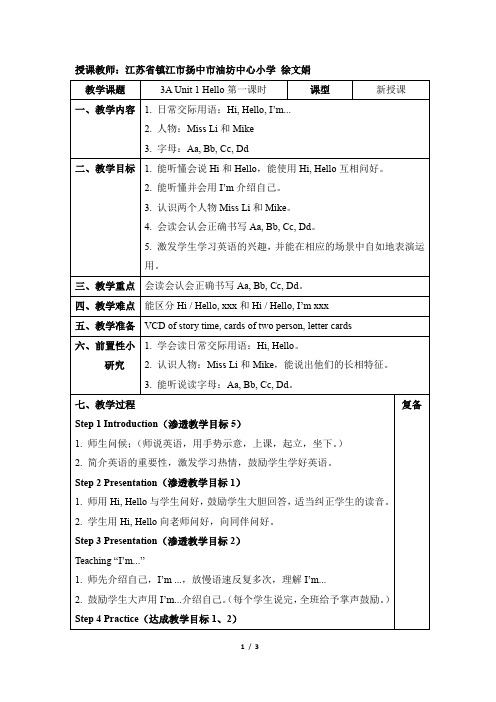
VCDofstorytime,cardsoftwoperson,lettercards
六、前置性小issLi和Mike,能说出他们的长相特征。
3.能听说读字母:Aa,Bb,Cc,Dd。
七、教学过程
Step 1 Introduction(渗透教学目标5)
1.师生问候;(师说英语,用手势示意,上课,起立,坐下。)
2.简介英语的重要性,激发学习热情,鼓励学生学好英语。
Step 2 Presentation(渗透教学目标1)
1.师用Hi,Hello与学生问好,鼓励学生大胆回答,适当纠正学生的读音。
2.学生用Hi,Hello向老师问好,向同伴问好。
Step 3 Presentation(渗透教学目标2)
2.能听懂并会用I’m介绍自己。
3.认识两个人物MissLi和Mike。
4.会读会认会正确书写Aa,Bb,Cc,Dd。
5.激发学生学习英语的兴趣,并能在相应的场景中自如地表演运用。
三、教学重点
会读会认会正确书写Aa,Bb,Cc,Dd。
四、教学难点
能区分Hi/Hello,xxx和Hi/Hello,I’mxxx
★我们还认识了4为字母朋友:Aa,Bb,Cc,Dd
你能得几颗星呢?★★★★★★
复备
八、作业设计
基础性作业:
1.★回家用所学的句型与父母问好;正确抄写四个字母4遍,注意占格和笔顺。
2.发展性作业:★★★用卡纸制作字母头饰;带头饰用句型进行自我介绍。
九、板书设计
Unit 1 Hello
十、教学反思
S:Hello,I’mMike.
3.学生戴上MissLi或Mike的头饰,下位走动,向本组同学问候。
译林小学英语5A Unit3 教案
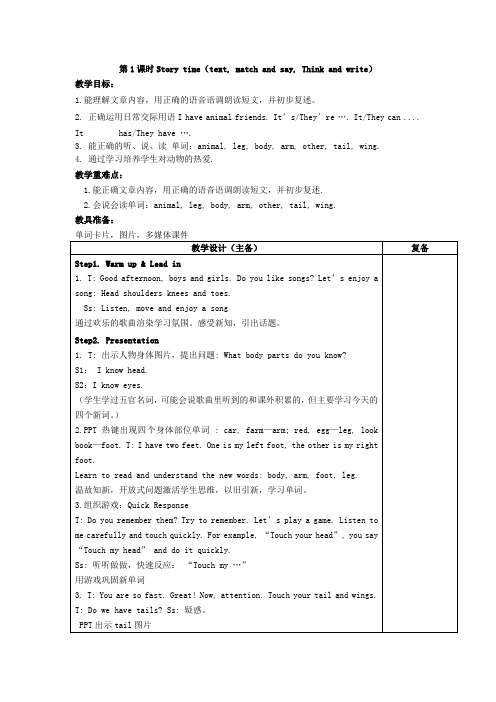
第1课时Story time(text, match and say, Think and write)教学目标:1.能理解文章内容,用正确的语音语调朗读短文,并初步复述。
2. 正确运用日常交际用语I have animal friends. It’s/They’re …. It/They can .... It has/They have ….3. 能正确的听、说、读单词:animal, leg, body, arm, other, tail, wing.4. 通过学习培养学生对动物的热爱.教学重难点:1.能正确文章内容,用正确的语音语调朗读短文,并初步复述.2.会说会读单词:animal, leg, body, arm, other, tail, wing.教具准备:第2课时Story time (words, Think and say)教学目标:1、能听懂、会读、会说并理解单词:have-has, doesn’t=does not,2、能够听懂、会说、会读句型:Do …have …? Yes, …do./No, …don’t. Does he/she have …? Yes, he/she does./No, he/she doesn’t.教学重难点:1、能够听懂、会说、会读句型:Do …have …? Yes, …do./No, …don’t. Does he/she have …? Yes, he/she does./No, he/she doesn’t.2、能简单的用第三人称描述动物。
教具准备:tape recorder第3课时Sound time and Cartoon time教学目标:1、能够听懂、会说、会读卡通故事中出现的词汇::fingers, hard, give,2. 能够流利地表达It has .. .. We have....的意思;3. 能够理解并掌握It likes....用法;4 能够听懂、会说、会读日常用语:Ouch!5. 能够整体理解并简单表演卡通对话教学重难点:1.学生能正确理解、朗读Cartoon time中的故事,能读懂其中的趣味之处,能在教师的指导下表演故事;2. .了解字母U在单词中的发音。
Unit 1 In class 教学设计(Story time)-三年级英语下册同步备课 译林版(三

Unit 1 In class 教学设计(Story time)-三年级英语下册同步备课译林版(三起)教学目标1.学生能够听懂并理解故事中的基本信息。
2.学生能够运用正确的语音和语调朗读故事中的句子。
3.学生能够通过回答问题加深对故事的理解。
教学内容本节课教学内容为三年级英语下册Unit 1 In class中的Story time。
教学重点1.学生能够理解故事中的基本信息。
2.学生能够正确朗读故事中的句子。
教学难点1.学生能够通过回答问题加深对故事的理解。
2.学生能够在不同语境下正确运用所学单词。
教学过程导入1.教师播放与故事相关的音频,并让学生猜测故事主题。
2.教师出示故事中的图片和单词卡片,让学生进行词汇预习。
正文1.教师朗读故事,并让学生跟读。
2.教师用简单英语向学生讲解故事内容,并检查学生理解。
3.教师将学生分成小组进行扮演故事中的角色,通过角色扮演巩固故事内容。
4.教师让学生回答与故事相关的问题,并加深对故事的理解。
结束1.教师与学生一起复习本节课的教学内容。
2.教师鼓励学生自主使用所学知识,提高英语口语表达能力。
教学资源1.与故事相关的音频。
2.故事中的图片和单词卡片。
课时安排1.本节课为45分钟。
讲评点评本节课通过运用PPT、图片、单词卡片等多种教学资源,结合角色扮演、问答等互动式教学方法,使学生更加轻松愉快地接受教学内容,并在说、读、写、听等各方面得到了充分的锻炼,达到了预期教学目标。
同时,本节课注重培养学生的英语学习兴趣,激发学生学习英语的积极性,有利于学生更好地掌握所学知识,提高英语口语表达能力。
Unit2AnewstudentStorytime(教案)译林版英语五年级上册

课题:Unit 2 A new student第一课时(S tory time)一、教学目标(知识与技能、过程与方法、情感态度与价值观三类目标)1. 能听懂、会说、会读、会写句型How many are there …? Is/Are there any…? Yes, there is/are.2.听懂,会说,会读,会写词汇:classroom, table tennis room, computer room, music room, on the first/second/third floor, show her around.3.能正确地理解并朗读对话,在教师的引导和帮助下尝试表演对话。
4.能初步运用本课所学的词汇和日常交际用语介绍自己的学校和场所。
二、教学重难点重点:1.句型:How many... are there …? Is/Are there any…? Yes, there ….2.词汇:classroom, table tennis room, computer room, music room, on the first/second/third floor, show her around难点:能初步运用本课所学的词汇和日常交际用语介绍自己的学校和场所。
三、教学准备挂图,卡片,多媒体(PPT)四、教学过程Step 1. Warm up & Lead in1. Guessing gameThere are many places in the school. What are they? Let’s guess.T: There are some desks and chairs in it. We can have lessons in it. Where is it?S: Classroom.T: You are right. Are there any classrooms in our school?S: Yes, there are.Step 2. Learn the new words and sentences1. Learn the new words以Guessing game的游戏,同法教授新词:art room, library, playground, computer room, music room2. Read the new words3. 新授句型:Is/Are there … ?Yes, there is/are. No, there is/are not.T: Is there a library?S: Yes, there is.T: Are there any table tennis rooms?S: No, there aren’t.Ask and answer in pairs.4. 教授序数词:first, second, third及句型It’s/They’re on the … floor.(引导学生对教师进行提问)S:Is there a computer room?T: Yes, there are two computer rooms. They’re on the third floor.教授新词:first,second,third5. 揭示课题T: Boys and girls, today, a new student joins us.PPT出示Nancy人物形象,She’ s new here.She’s a new student.Unit2 A new student揭示课题,带读。
Unit 3 Our animal friends第1课时(story time)(教学设计)-20
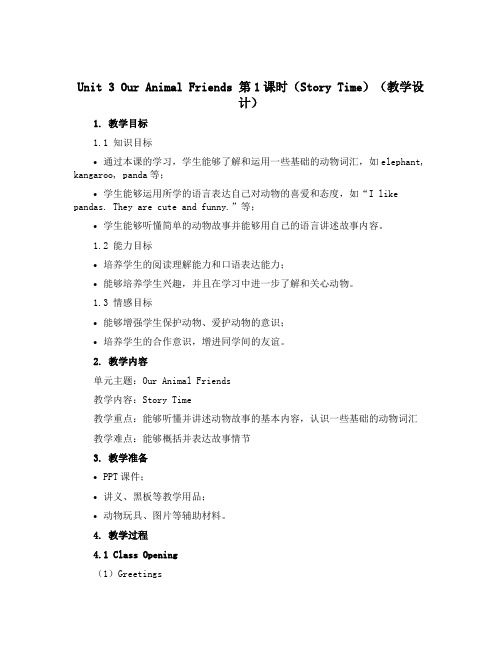
Unit 3 Our Animal Friends 第1课时(Story Time)(教学设计)1. 教学目标1.1 知识目标•通过本课的学习,学生能够了解和运用一些基础的动物词汇,如elephant, kangaroo, panda等;•学生能够运用所学的语言表达自己对动物的喜爱和态度,如“I like pandas. They are cute and funny.”等;•学生能够听懂简单的动物故事并能够用自己的语言讲述故事内容。
1.2 能力目标•培养学生的阅读理解能力和口语表达能力;•能够培养学生兴趣,并且在学习中进一步了解和关心动物。
1.3 情感目标•能够增强学生保护动物、爱护动物的意识;•培养学生的合作意识,增进同学间的友谊。
2. 教学内容单元主题:Our Animal Friends教学内容:Story Time教学重点:能够听懂并讲述动物故事的基本内容,认识一些基础的动物词汇教学难点:能够概括并表达故事情节3. 教学准备•PPT课件;•讲义、黑板等教学用品;•动物玩具、图片等辅助材料。
4. 教学过程4.1 Class Opening(1)Greetings•T: Good morning/afternoon, class.•S: Good morning/afternoon, teacher.•T: How are you everyone?•S: I’m fine, thank you. And you?•T: I’m good, thanks. Please sit down.(2)Review•T: Yesterday, we learned some animal words, like panda, kangaroo, and koala. Can you remember them?•S: …(Teacher can use some visual aids to help the students remember the animal words they learned yesterday, such as showing pictures of the animals on the board.)4.2 Presentation(1)Introduce the story•T: Today, we are going to read a story about some animals. (Show the book and the title of the story on the board.) The title is。
人教版(新起点)英语五上《Revision 1》(Story Time)教学设计

Revision1 Story Time教学设计【内容来源】人民教育出版社(一起点)五年级上册Revision1【课时】Story Time一、教学目标1. 能够在教师的引导下,借助图片和其他阅读策略读懂本单元的故事,完成故事填空活动,并尝试表演故事。
2. 能够通过学习小故事,体会做任何事都要认真,做事糊弄将会给自己带来更大的麻烦。
二、教学建议1. 热身导入(1) 唱本单元Fun Time C项歌曲。
(2) 复习词和功能句①复习一、三单元部分重点词汇:教师出示一单元和三单元的词汇,一个学生朗读,坐在他/她后面的同学进行造句练习。
②师生交流教师出示图片并提问:Look, so many animals! Do you like animals? What is your favourite animal? Why?等。
复习前面第一、二单元功能句。
③通过师生交流引出本课的主人公:三只小猪和一只大灰狼。
2. 呈现故事让学生初步感知故事大意。
(1) 师生交流了解故事:Have you ever read the story Three Little Pigs? What is the story about? 学生两个一组回忆并讨论故事情节。
教师提问:Does the bad wolf eat the little pigs? Do you remember?(2) 学生带着问题浏览故事,感知故事大意。
3. 整体感知故事教师播放故事录音,整体感知故事。
4. 图片环游,理解故事细节教师引导学生认真观察图片,可以提以下问题:图1: What are these three little pigs like? What kind of houses are they building?图2: The bad wolf comes. What are they talking about? Guess. 学生讨论,自由发言。
译林版六年级英语上册六上U4第1课时(Story+time)教案精品
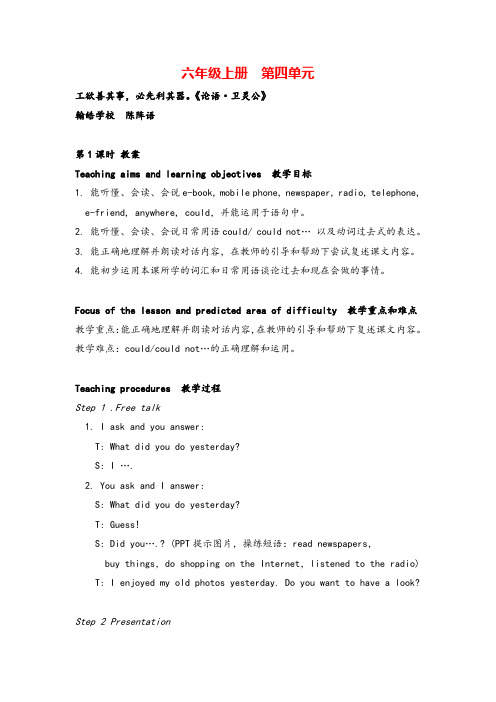
六年级上册第四单元工欲善其事,必先利其器。
《论语·卫灵公》翰皓学校陈阵语第1课时教案Teaching aims and learning objectives 教学目标1. 能听懂、会读、会说e-book, mobile phone, newspaper, radio, telephone, e-friend, anywhere, could,并能运用于语句中。
2. 能听懂、会读、会说日常用语could/ could not…以及动词过去式的表达。
3. 能正确地理解并朗读对话内容,在教师的引导和帮助下尝试复述课文内容。
4. 能初步运用本课所学的词汇和日常用语谈论过去和现在会做的事情。
Focus of the lesson and predicted area of difficulty 教学重点和难点教学重点:能正确地理解并朗读对话内容,在教师的引导和帮助下复述课文内容。
教学难点:could/could not…的正确理解和运用。
Teaching procedures 教学过程Step 1 .Free talk1. I ask and you answer:T: What did you do yesterday?S: I ….2. You ask and I answer:S: What did you do yesterday?T: Guess!S: Did you….? (PPT提示图片,操练短语:read newspapers,buy things,do shopping on the Internet,listened to the radio) T: I enjoyed my old photos yesterday. Do you want to have a look?Step 2 Presentation1. T: Look! These are my photos. Long long ago, I could do many things.(PPT出现would,引导学生说出could的读音)2. (PPT出现图片和句型)T: Thirtyyears ago, I could ride a bike.Twenty years ago, I could play basketball.Ten years ago, I could swim.(教师脸上做自豪状)How about you? (引导学生用PPT上的句型来表达)________ years ago, I could________3. T: You really did a good job. Let’s get more callenges. Are you ready? (PPT上句型稍作变换:________ years ago, I could not…. But now I can. 学生先操练,然后选择一小组学生进行non-stop talking。
五年级上册英语教案-Unit 8 At Christmas 课时1 ( Story time) 译林

五年级上册英语教案-Unit 8 At Christmas 课时1 ( Story time)译林三起教学目标:1. 知识与技能:学生能够理解并朗读Story time部分,学习有关圣诞节的传统习俗和活动。
2. 过程与方法:通过图片、视频、故事等多种形式,激发学生的兴趣,培养他们的阅读能力和词汇运用能力。
3. 情感态度价值观:通过学习本课,学生能够了解西方文化,培养跨文化交际意识,同时增强对英语学习的兴趣和自信心。
教学内容:1. 词汇:圣诞节、圣诞树、礼物、圣诞老人、颂歌等。
2. 句型:—What do you do at Christmas? —I ...教学重点与难点:1. 教学重点:学生能够理解并运用本课所学词汇和句型,描述圣诞节的习俗和活动。
2. 教学难点:正确朗读并理解Story time部分的内容,掌握相关词汇和句型的用法。
教具与学具准备:1. 教具:PPT、视频、音频、图片等。
2. 学具:学生自备英语课本、笔记本、彩笔等。
教学过程:1. 导入:通过播放圣诞歌曲,让学生了解圣诞节的文化背景,激发他们的学习兴趣。
2. 新课呈现:利用PPT展示Story time部分的图片,引导学生理解故事内容,学习新词汇和句型。
3. 操练:通过角色扮演、小组讨论等形式,让学生运用所学知识,描述圣诞节的习俗和活动。
4. 巩固:播放Story time部分的录音,让学生跟读,并完成相应的练习。
5. 总结:教师对本节课的内容进行总结,强调重点和难点,帮助学生巩固所学知识。
板书设计:1. Unit 8 At Christmas2. 重点词汇:圣诞节、圣诞树、礼物、圣诞老人、颂歌等。
3. 重点句型:—What do you do at Christmas? —I ...作业设计:1. 听力作业:听Story time部分的录音,并跟读。
2. 书面作业:完成课后练习,巩固所学知识。
3. 口语作业:与同学或家人用英语分享圣诞节的习俗和活动。
Unit 2 Dinner is ready 第一课时story time(教案)
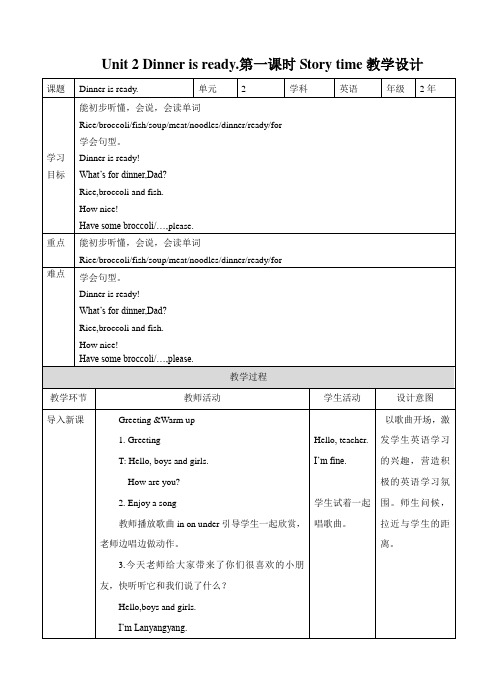
Guess!What are they?
原来啊,它给我们带来了很多水果,但是要我们猜一猜,你们有信心猜到吗?
Hello, teacher.
I’m fine.
学生试着一起唱歌曲。
生猜单词,
以歌曲开场,激发学生英语学习的兴趣,营造积极的英语学习氛围。师生问候,拉近与学生的距离。
生试着读一读。
生猜:面条
Read it one by one.
生猜食物单词。
读出单词。
通过猜谜的游戏,学生更喜欢参与活动。而且能够把单词的意思和图片在一起。让孩子们更加的感兴趣,乐于参与。
锻炼学生的观察能力,有助于学生对单词的记忆。
猜谜,学生们很喜欢,而且单词练习的很全面,参与度高。
游戏操练单词
4.Story.
T: Hello, boys and girls.
How are you?
2.Enjoy a song
教师播放歌曲in on under引导学生一起欣赏,老师边唱边做动作。
3.今天老师给大家带来了你们很喜欢的小朋友,快听听它和我们说了什么?
Hello,boys and girls.
I’m Lanyangyang.
Good job.Now let’s go.Magic eyes!
看到单词快速读出来。
I have some pictures. I read these words.
你们猜一猜,下面的这些单词,是和哪个图片对应的。
教师指着图片读单词。
生猜:米饭
跟读单词
生答:花椰菜。
跟读单词
Yes,fish
跟读单词。
Lingling要吃晚餐了,让我们一起去看看他们吃什么吧!老师又2个问题。
五年级上册英语说课稿-Unit 3 Our animal friends 第一课时Story tim

五年级上册英语说课稿-Unit 3 Our animal friends 第一课时Story time一、选用教材译林版三年级英语(上)Unit 3 Our animal friends 第一课时Story time二、教学目标1.能听懂、理解故事中的词汇和句子。
2.能根据图片和故事内容进行简单的口头描述。
3.能够回答关于故事的简单问题。
4.能够模仿并尝试用正确的语音和语调朗读故事。
三、教学重点1.能听懂、理解故事中的词汇和句子。
2.能根据图片和故事内容进行简单的口头描述。
四、教学难点能够模仿并尝试用正确的语音和语调朗读故事。
五、教学准备1.教师和学生用的教材2.教师和学生的课前准备(注意发音、语调、语音)3.黑板、粉笔六、教学过程1. 导入(3分钟)让学生看一张关于动物的图画,让学生谈论什么样的动物他们喜欢或不喜欢,以及为什么。
2. 学习故事(20分钟)1.带领学生熟悉故事中的单词和句子。
2.教师读故事并为学生解释故事情节。
3.让学生再读一次故事,并帮助他们理解它。
4.让学生自己朗读故事,让他们尽可能地模仿说故事的语调和语音。
3. 练习(15分钟)练习动物的名称和动作,让学生练习用正确的单词和句子来描述动物。
鼓励学生尝试自己造句子并进行说法。
4. 总结(2分钟)教师为学生总结本节课所学到的知识和技能,然后检查学生对课程的理解。
七、教学评价1.通过学生的口头描述和问题回答,检查学生是否能听懂和理解故事中的内容。
2.通过学生的朗读和描述,检查学生是否能模仿故事中的语调和语音,并正确使用单词和句子。
八、课后拓展1.让学生制作一篇关于他们喜欢的动物的简短作文。
2.让学生寻找和班级中学过的动物相关的信息,并建议他们把这些信息制作成海报或展示。
3.带领学生去动物园或野生动物公园进行现场教学和实践学习。
九、教学反思通过本节课的教学活动,学生可以在趣味中学习英语,提高他们的英语听说和阅读能力。
同时,教师也需要注重在教学过程中对学生的语音语调进行纠正和提醒,以帮助学生制定正确的英语口音和语音习惯。
- 1、下载文档前请自行甄别文档内容的完整性,平台不提供额外的编辑、内容补充、找答案等附加服务。
- 2、"仅部分预览"的文档,不可在线预览部分如存在完整性等问题,可反馈申请退款(可完整预览的文档不适用该条件!)。
- 3、如文档侵犯您的权益,请联系客服反馈,我们会尽快为您处理(人工客服工作时间:9:00-18:30)。
Unit 5 Seasons
Story time
祝令珍
Teaching contents教学内容
Story time
Teaching aims and learning objectives教学目标
1. 能听懂、会读、会说:fly, kite, go boating, go swimming, picnic, go
climbing, go skating。
2. 能听懂、会读、会说日常用语:In spring, it is warm. We go boating.
3. 能正确地朗读并理解语篇内容,在图片和语言提示下复述语篇。
4. 能初步运用本课所学的词汇和日常用语谈论不同季节的气候特征以及在不同
季节里人们经常从事的活动。
Focus of the lesson and predicted area of difficulty 教学重点和难点教学重点:能正确地朗读并理解语篇内容,在图片和语言提示下复述语篇。
教学难点:能初步运用本课所学的词汇和日常用语谈论不同的季节和人们的活动。
Teaching procedures 教学过程
Step 1 Free talk
1. T: It’s a warm day today, isn’t it?
S: …
(出示课件图片,学习warm)
T: What do we do on warm days?
S: We …
(出示课件图片,学习:go boating, fly kites, pick strawberries, …) 【设计意图:师生通过谈论天气和人们的活动为课文学习进行铺垫。
如果天气不好(不温暖),可以通过课件中的图片直接引入学习。
】
2. Talk in groups
(1) T: Look at this picture, how’s the weather?
S: It’s hot.
(出示课件图片,学习:hot)
T: What do we do on hot days?
S: …
(2) T: How’s the weather in this picture?
S: It’s cool.
T: Do you like cool days? What do we do on cool days?
S: …
(3) T: Is it cool?
S: No. it’s cold.
(通过课件图片继续学习cold)
T: Do we go climbing on cold days? What do we do on cold days?
S: …
【设计意图:结合天气特色明显的三幅图学习:hot, cool, cold。
并通过:What do we do on … days? 引发学生对不同天气人们的不同活动进行思考,进一步为话题学习铺垫情境。
】
Step 2 Say a rhyme
1. Ask and answer
T: How’s the weather?
S: It’s warm/hot/cool/cold.
T: What do we do on warm/hot/cool/cold days?
S: We go boating/go swimming/go climbing/go skating.
(学习go boating/go swimming/go climbing/go skating)
2. Learn to read the rhyme
(出示Rhyme:
Warm, warm, let’s go boating.
Hot, hot, let’s go swimming.
Cool, cool, let’s go climbing.
Cold, cold, let’s go skating. )
3. Read it together
【设计意图:通过朗诵韵律小诗,帮助学生强化新词warm, hot, cool和cold 的语音,强化词组go boating, go swimming, go climbing和go skating的语义,为课文学习做好铺垫。
】
Step 3 Presentation:
1. Watch and answer
T: We are happy today. Let’s watch a cartoon together. Then tell me, what’s the cartoon about?
S: It’s about seasons.
(学习seasons)
2. Read and answer
T: How many seasons are there in one year?
S: There are four.
T: What are they in English? Read the passage quickly and find the answers.
S: …
(学习spring, summer, autumn, winter)
3. Read and underline
T: What do they do in different seasons? Please read and underline the activities.
S: …
4. Read in pairs
T: Check your answers in pairs. And try to read with your partner. S: …
5. Read and learn
T: What do they do in spring/summer/autumn/winter?
S: …
(学习fly kites, eat ice creams, have picnics, make snowmen)
6. Listen and repeat
T: Listen to the tape and repeat Story time.
S: …
【设计意图:通过观看动画了解语篇的主题Seasons,展开话题的学习。
让学生在朗读中回答、划线和学习,在跟读中强化语音知识,注重学生语音、语调的训练和培养。
】
Step 4 Consolidation
1. Try to retell the passage in groups
T: Please retell the passage about seasons in groups of four.
S: …
2. Let some groups retell in class
T: Who’d like to retell the passage in class?
S: …
【设计意图:请学生在语篇学习的基础上,进行模仿和复述。
小组合作的形式可以降低活动的难度,增加活动的趣味性。
可鼓励学生在原文的基础上进行改编和补充。
】
Homework 家庭作业
1. Read and recite the passage.
2. Think about more activities in different seasons.
3. Prepare some photos of your favourite season and bring them to class next time.
Teaching aids 教学准备(含板书设计)
教学准备:PPT课件及相关音、视频文件,单词卡片。
板书设计:
说课
本节课作为单元的起始课时,主要以图片和文字的形式呈现了四个季节的气候特征以及孩子们在这四个季节中通常做的活动,表达了对自然和生活的热爱。
教学内容的设计主要有以下几个特点:
1. 始终围绕Seasons的主题展开学习。
从不同天气对人们活动的影响开始谈
起,再结合动画了解不同季节的气候特征,最后将季节、气候和人们的活动相结合进行学习。
始终围绕着Seasons这一主题,有利于学生的学习,符合循序渐进的学习规律和原则。
2. 语篇学习前的语言铺垫为语篇学习降低了难度。
作为四下学习内容,本语
篇的目标词汇和句型偏多。
为了降低学习的难底,在语篇学习前设计了
Free talk的环节,请学生根据所提供的图片和实际情况进行谈论,鼓励学
生根据自己平时的观察,用已有的知识进行简单描述和回顾,并提前学
习了本课部分目标词汇。
3. 注重在语篇学习的过程中,培养学生获取信息的能力和表达能力。
在语篇
学习中,活动的设计注重学生学习能力的培养。
通过看动画找主旨,读
课文找关键词以及划出目标短语等活动来培养学生的阅读能力;朗读的
训练和复述的活动设计都可以有针对性地训练学生的语言素质和语言输
出的能力,为进一步的学习进行语言铺垫,为能力提升打好基础。
